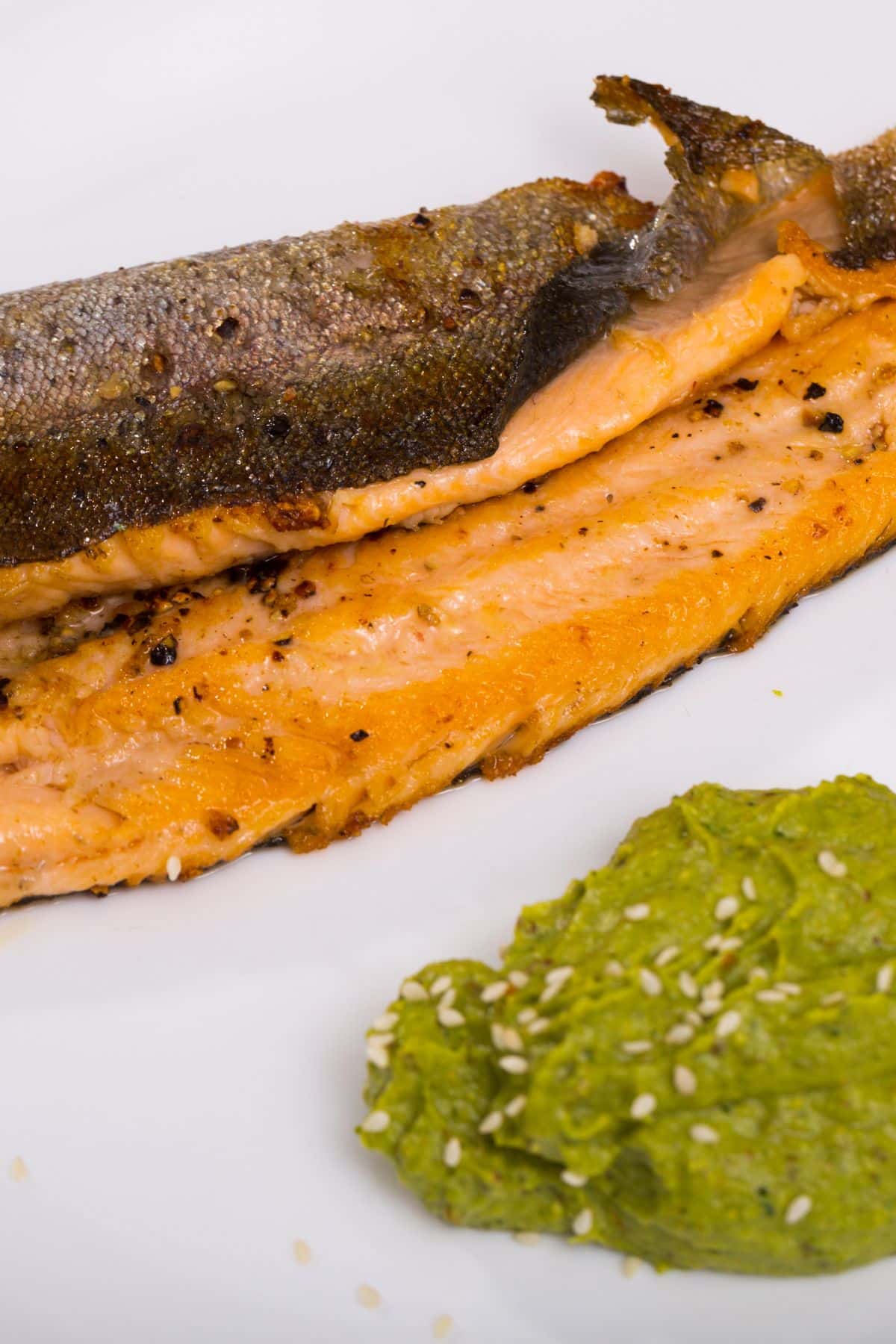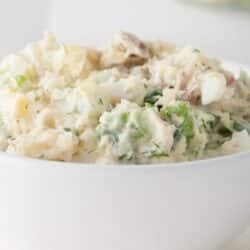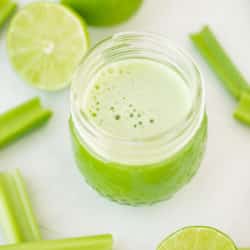Is Trout Healthy (Nutrition Pros and Cons)?
In this blog post, I’ll review whether trout is healthy or not? Find out what this white fish’s nutrition pros and cons are, plus some ideas on how to prepare it.

Trout Info
Trout is a freshwater fish typically found in cold lakes and rivers and sometimes in the ocean. It is also extensively farmed.
Closely related to salmon, trout has a mild flavor and is an excellent source of protein and omega-3 fatty acids. The American Heart Association recommends eating two servings of fish per week for most people (pregnant women should ask their healthcare provider first).
Consuming fish regularly can reduce the risk of heart attacks, reduce heart disease, help with weight loss, reduce high blood pressure, and is part of a healthy diet.
There are several species of trout including lake trout, rainbow trout, brown trout, steelhead trout, and wild trout.
Nutrition Pros
Sustainably sourced trout is exceptionally healthy. It contains significant protein levels, healthy fats, vitamins, and minerals.
Unlike so many other types of fish and seafood, trout has relatively low levels of mercury and other contaminants.
Here are some of the main nutritional benefits of trout and the reasons why it’s considered one of the healthiest fish to consume.
1. Trout is an excellent protein source
A fairly small 3-ounce serving of cooked rainbow trout contains around 19 grams of protein which makes it a good source of protein.
Protein is vital for your muscles, hair, skin, nail, cartilage, and blood. It’s why proteins are known as the building blocks of the body.
Besides all the health benefits, protein keeps you fuller for longer, provides energy, and repairs and builds muscles and bones.
2. It’s high in omega-3 fatty acids
Omega-3 fatty acids are essential fatty acids that are vital for healthy aging, and your body can’t make them.
Since trout is rich in omega-3 fatty acids, it can help you get some of this vital nutrient.
Just one cooked serving of rainbow trout contains almost double the omega-3 fatty acids you need in a day.
3. Trout is a good source of potassium
Potassium is an essential mineral that helps balance your body and blood pressure.
Certain types of fish including trout are considered a high potassium food.
4. It’s also rich in phosphorous
Besides calcium, phosphorous is the most abundant mineral in our bodies. Together, the two minerals maintain our bones and teeth.
A serving of trout contains 39% of the RDA of phosphorous.
5. Rainbow trout is an excellent source of B-vitamins
The vitamin B complex comprises thiamin, niacin, vitamins B6, B12, and pantothenic acid. These vitamins all play a valuable role in cell metabolism.
Trout is especially rich in vitamins B6 and B12.
6. It contains selenium
Although many people have not heard of this trace mineral, it’s super important for a healthy immune system, brain function, and fertility.
Rainbow trout is also an excellent source of selenium.

In addition to the nutritional benefits listed above, trout has other characteristics which make it one of the best fish to consume. Not only does it contain b vitamins and omega-3 fats (docosahexaenoic acid), but it also has vitamin D and vitamin E.
Nutrition Cons
Because of industrial activity and pollution, nearly all fish and shellfish contain traces of toxic mercury. Some seafood also contains other contaminants.
Consuming mercury in large amounts can negatively affect the central nervous system, liver, and kidneys and cause problems with the immune system.
The FDA states that an average trout contains around 0.141 mcg of mercury. If you weigh around 160 pounds, you’d have to eat approximately 50 medium-sized trout to reach the limit. Compared to other fish, like bluefin tuna, swordfish, and King mackerel, trout contains significantly less mercury.
When eaten in moderation, the health benefits may outweigh the risk of consuming toxins. But, it is up to you to include food containing any amount of this toxic metal.
How to Prepare Trout
Including trout in your diet gives you a healthy, delicious, and super easy-to-prepare protein. You can cook trout from frozen or thaw it first. Here are some cooking options you can try.
Before cooking your trout fillets, season them with salt and pepper or any other seasoning you like.
Oven-roasted trout:
- Place your trout fillets in a baking tray.
- Brush them with olive oil or melted grass-fed butter and cover them with parchment paper.
- Roast them in an oven preheated to 375°F – 400°F for 15 to 20 minutes.
Broiled trout:
- Lay the trout fillets with the skin down in a baking tray.
- Turn the broiler on high and place the trout around four inches from the broiler for three to five minutes.
Poached trout:
- Place the trout fillets in a saucepan and cover with stock.
- Cook the fillets on low heat for six to eight minutes.
Grilled trout:
- Lightly oil your grill’s grates.
- Set it to medium heat and cook the trout for around three minutes on either side. Trout fillets are delicate and may fall apart, so be careful when you flip them over.
Sautéed trout:
- Place your trout flesh down in a lightly oiled pan on medium heat.
- Sauté the fillets for two to three minutes on each side.
Whether you roast, broil, poach, grill, or sauté your trout, turning this delicate and delicious fish into a tasty and nutritious meal in minutes is easy. You can season the trout with your choice of herbs or spices. It also pairs well with creamy sauces and herbal butter.

Trout Nutrition FAQs
Farmed and wild-caught rainbow trout have minor nutritional differences. Wild-caught trout contains slightly more iron and calcium, while farm-raised trout contains more selenium and vitamin A.
Determining which seafood is a sustainable and safe choice can be complicated. Farm-raised trout is generally more sustainable than wild-caught varieties.
Most farmed trout in the United States is grown in a non-consumptive aquaculture process, so it’s usually a responsible choice. Farming trout helps reduce the stress on wild fish populations and gives them time to grow back.
Conclusions
When consumed in moderation and from quality sources, trout is considered a healthy food for most people. It is rich in lean protein, omega-3 fatty acids, and other important vitamins and minerals. Additionally, trout contains fewer environmental toxins such as mercury than other types of fish and seafood. Consider adding trout to your list of healthy foods to consume.
Don’t Miss These Food Reviews!
About the Author: Carrie Forrest has a master’s degree in public health with a specialty in nutrition. She is a top wellness and food blogger with over 5 million annual visitors to her site. Carrie has an incredible story of recovery from chronic illness and is passionate about helping other women transform their health. Send Carrie a message through her contact form.
Don’t forget to join my newsletter list to get exclusive clean eating recipes and tips. The newsletter is 100% free with no spam; unsubscribe anytime.
Note: this post is for informational purposes only and is not intended as medical advice. Please consult your healthcare provider for recommendations related to your individual situation.






















